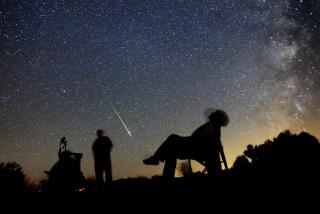Comet Fragments Begin Crashing Into Jupiter : Astronomy: Impact of first chunk creates a Gargantuan fireball. Scientists are elated at the images.
- Share via
The world’s astronomers focused Saturday on Jupiter as mountain-sized fragments of a shattered comet--traveling 60 times faster than a bullet--began raining down on the dark side of the solar system’s largest planet, triggering a fireball half the size of Earth.
After the predicted impact of the first--and smallest--chunk of comet Shoemaker-Levy 9 at 1 p.m., astronomers in Spain and Chile reported seeing a large plume as the impact site rotated into view. Within 90 minutes, the fiery plume had grown into a huge fireball 4,000 miles across and 1,000 miles high, NASA astronomers said late Saturday.
The plume is brighter than anything else on Jupiter and brighter than its brightest moon, Io, said comet co-discoverer Eugene Shoemaker. “I mean, it’s bright!” he exclaimed.
When the first raw image from the Hubble Space Telescope showed evidence of what appeared to be the plume from the first impact, scientists gathered around the video monitor gasped in astonishment and then shouted with glee.
They swigged celebratory champagne straight from bottles. “We actually saw some amazing things,” said planetary astronomer Heidi B. Hammel at NASA’s Goddard Space Flight Center outside Washington.
“We can actually see the impact site,” she said. “It is a new feature on Jupiter, and we are going to have 20 more of them this week, each one even brighter.”
Although the impacts were all to take place out of Earth’s vision, Jupiter rotates so quickly that the impact sites come into view within half an hour of each collision.
Virtually every major telescope in the world was trained on the giant planet as the first of 21 chunks of the comet hit the night side of Jupiter on schedule.
Thousands of astronomers jockeyed for the best view--from the South African Astronomical Observatory outside Cape Town and the Palomar Observatory outside San Diego to a thicket of eight observing stations atop Mauna Kea in Hawaii, and NASA’s airborne observatory circling the globe at 41,000 feet over Australia.
The Hubble telescope, orbiting well above the atmosphere that blurs the vision of earthbound observers, has one of the best views of Jupiter and is expected to take hundreds of images of the impact sites in the coming week. NASA also has launched high-altitude sounding rockets from New Mexico.
In all, three major fragments of debris were expected to blast through the planet’s swirling cloud cover by midnight Saturday, with others bombarding the planet at about six-hour intervals for the next six days. The largest piece of comet is expected to hit Jupiter on Wednesday.
Although the first comet fragment hit just after lunchtime, scientists did not see any processed images of Jupiter, taken by NASA’s space telescope, until late Saturday.
Denied a direct view of the shooting stars, scientists were searching for aftereffects of the impacts--from lightning-like flashes reflected on Jupiter’s many moons, to shock waves rippling the giant planet’s thick atmosphere or minute temperature changes caused by the massive release of energy. Some scientists have suggested that the comet would strike with more force than all the nuclear weapons on Earth combined.
Shoemaker, an astronomer at the Lowell Observatory in Flagstaff, Ariz., discovered the comet this year with his wife, astronomer Carolyn Shoemaker, and colleague David H. Levy, an astronomer at the Palomar Observatory.
“I had a real emotional attachment to this comet,” said Carolyn Shoemaker. “All this time it has been such an object of beauty to me. I have to admit that I had a momentary tear when I realized the (impact) had happened.”
Amateur and professional sky-watchers have been riveted for months by the prospect of the collision because it is the first time people have discovered a celestial object and then been able to predict its impact on a planet accurately any more than a few seconds in advance.
More important, perhaps, it also is the first time humans have seen a comet collide with a planet. Scientists are excited at the prospect of gaining any insights they can into the kinds of collisions that have left their mark on every planet and moon in the solar system.
“We are very fortunate to be part of this suicidal comet experience,” said Donald K. Yeomans, a comet expert at Jet Propulsion Laboratory in Pasadena. “This is a chance to take a quantum leap forward in our understanding of what a comet is.”
Until Saturday, scientists were not sure whether the Shoemaker-Levy comet would cause the kind of cataclysm that may have destroyed the dinosaurs on Earth 65 million years ago or just a cosmic fizzle, of interest only to dedicated comet watchers.
“Well, it looks like this comet was not a dud,” said Hal Weaver, an astronomer at the Space Telescope Science Institute in Baltimore.
Jupiter--a ball of frozen and compressed helium and hydrogen 300 times more massive than the Earth--is so large that scientists expect it to easily absorb the comet’s energy. They expect no consequences to Earth, which will be more than 400 million miles away from Jupiter during the impacts.
* Times Link: 808-8463
To commemorate humankind’s first steps on the moon 25 years ago Wednesday, TimesLink features historic audio clips beginning in 1961 with President John F. Kennedy declaring the goal of landing a man on the moon, as well as other lunar anniversary features. To hear any of these clips, call TimesLink and press * and the four-digit code for the category you want to hear. Kennedy’s moon speech: *6200 Launch of Apollo 11: *6201 Life aboard Apollo 11: *6202 Space news update: *6203 Astronaut’s horoscopes: *6204 The Eagle lands on moon: *6205 Problems landing on moon: *6206 “That’s one small step...”: *6207 Aldrin’s first step: *6208 Nixon phones astronauts: *6209 Unveiling lunar plaque: *6210 Armstrong shoots photos: *6211 Collecting lunar samples: *6212 Lunar blast-off: *6213 Splashdown and recovery: *6214 World events, July, 1969: *6220 Pop music of July, 1969: *6221 Aldrin anniversary speech: *6222 Call TimesLink from area codes 213, 310, 714, 818 or 909. From other regions, use the area code nearest you.






